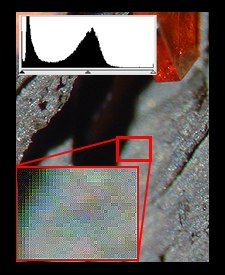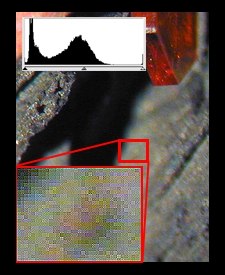
|
|
||||
|
Digital Photography
vs. Traditional Photography |
||
|
Grain vs. Noise So what happens when we push a digital camera beyond its design limits? What happens at the fringe of its ability to resolve density? Higher speed traditional film and film that is "pushed" will produce more grain. The image becomes more grainy looking and less sharp. When the ccd cell is pushed to higher light sensitivity, it responds with more "noise". The ccd cell in a digital camera is an electronic device, and virtually all electronic devices produce noise. Noise is the base level signal produced when it is in a rest state. For any electronic device to work well there must be a good signal to noise (S/N) ratio. All electronic transducers (things that turn a measured physical energy to an electric impulse) have a signal to noise ratio associated with them. A microphone turns sound energy to electronic impulses, and we hear the electronic version of the sound. The higher the signal to noise ratio the better the quality of sound. Look at the charts below. The bottom line represents a noise level for a ccd cell, and the top line represents a signal that the ccd cell is measuring. The more distance between the two lines, the easier it is to separate the background noise from the signal and we measure the signal with better precision. (These graphs are representational and not from a real cell.) |
||
|
|
 |
|
|
|
 |
|
|
Figure 1. shows a good separation level, and all of the signal is well separated form the noise. So we would expect a good image with little or no distortion. The photo to the right of Figure 1. shows fairly clean patterns in mid tone areas, and there is some differentiation of detail in the darkest area. So there is good separation. In this image the image was flooded with light and a higher shutter speed was used. As we try to stretch the sensitivity of the ccd cell, its noise level increases, and it begins to overlap the signal level. See Figure 2. Look at the photo to the right of Figure 2., and notice that there appears to be random patterns of yellowish pixels. This is where there is overlap in the signal to noise, and the yellow is some noise getting through. This picture was shot using less light and a longer exposure time. The shadow area is without resolution. Again the signal to noise is insufficient to differentiate any image or differences in the darkest areas. The noise level is high enough to come through during the longer sampling time in the better exposed areas. In most ccd cells noise shows up as random patterns of color spread throughout the image. The best way to avoid this is to use good lighting where signal to noise in very high. Don't try to push the ISO value of the ccd cell to higher values than it was designed to use, or it will produce this type of noise. In a perverse sort of sense. the noise does appear to be colored grain in the image. With traditional film, the grain is more neutral but gives the image a kind of sandy look at higher ISO values. Perhaps there is not as much difference between the two technologies and how they respond at their fringes. |
||
|
So when can I shoot the next picture? Digital cameras take longer between shutter presses than traditional cameras. The limiting factor with a 35 mm camera shooting multiple images is fundamentally the speed of film advance. Many midrange 35 mm cameras now have auto advance as a standard feature, and it is common to be able to shoot 2- 4 photos per second. Digital cameras have more problems in this area, and at first glance it is a bit weird. After all there are digital camcorders that can image 30 frames per second, and give far better quality than their analog counter parts. So what gives. In short the answer is RESOLUTION and a bit of design. The DV camcorders are collecting data at 720 x 480 resolution or about 1/3 mega pixel per frame. They also have the advantage of continuous operation in roughly the same lighting situation. They are designed to optimise differences between frames, and they work at what we now consider low resolution for still video cameras. The highly automated digital cameras of today must accomplish several tasks before the image is taken. In AUTO mode they must focus the lens, take a meter reading, decide on the necessity for flash, be certain the ccd cell is ready, be certain the previous picture is already saved to memory, and then expose the picture. In auto mode there is a real delay between the time you press the shutter button and the time the image is exposed. Auto focus is probably the slowest thing in this chain and various greatly on different camera models. In some instances, the time to write the previous image to memory may also be a real problem. Your still digital camera is typically imaging at 2 or 3 megapixels, as much as 10 times more data per image than a digital camcorder. It takes a longer time to prepare the ccd cell to capture the image, and it takes longer to transfer the image to camera memory after it is exposed. The S/N ratio on a camcorder is usually better than that of your still camera simply because of its lower resolution, and hence larger individual cell size on the sensor. After a ccd cell is exposed to light, it must transfer its data to memory, then be allowed to drop back to its signal free state (rest state) as it prepares to capture the next image. A digital still camera does not make the assumption that the next image will be similar to the previous one. Some still digital cameras can now be set to shoot several images in succession. They approach this in two ways. For those cameras that can operate like a camcorder, they drop to lower resolution to collect a fixed duration of recording. Typically they drop to 640x480 and can capture several seconds of continuous images. I have yet to see one that can capture high resolution pictures for several seconds. The second way they can capture multi frames is to preset their controls for a burst of frames. Some cameras do this to take 3 pictures in a row changing either the f-stop or ISO rating with each image. In this case the camera meters the image once, then automatically makes the preselected changes without metering or refocusing between each image. The camera already knows that the images will be very similar as the shots are taken quickly in succession. It is not necessary to let the ccd cell return to a complete rest state for each image as the light striking each will be very similar in intensity. In these situation higher resolutions are tolerated, but rarely the highest. Everything is a trade off and a balancing act. So as we push the muti-megapixel barrier higher and higher the cameras will need more time to move their captured images to memory, and more time to reset to a high S/N ratio. Technology will solve or at least improve these problems with time but for now we must live with them. As mentioned else where in this document, it is good idea to test any digital camera before you buy if quick shooting is a necessity or you may be disappointed in the response times. Many digital cameras cannot be taken out of automatic mode and thus you are forced to wait for the automation. |
||